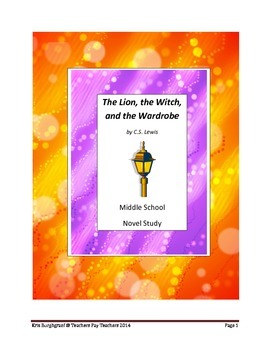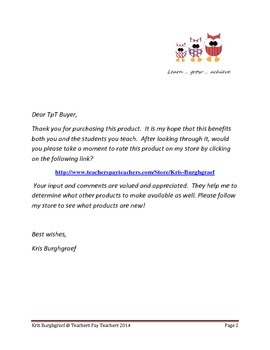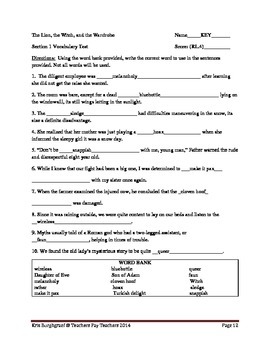The Lion, the Witch, and the Wardrobe (C.S. Lewis) NOVEL STUDY
- PDF
Description
Fantastic middle school ELA unit! Focused on exploring fantasy elements within this book, digging for vocabulary meaning, citing and using inferences, and developing written responses. Unit is developed in 5 different sections---go as fast or as slow as you want! This unit is developed for middle school---adapt to your specific grade level.
Ideas on how to use this unit: whole class discussion, small group learning, student "go beyond" challenge, pick apart and use what you want.
Common Core Standards used in this unit
Cite Evidence/Infer
CCSS ELA-Literacy-RL.1: Cite textual evidence to support analysis of what the text says explicitly as well as inferences drawn from the text.
Progress of Plot/ Relationships
CCSS ELA-Literacy-RL.3: Describe how a particular story’s or drama’s plot unfolds in a series of episodes as well as how the characters respond or change as the pot moves towards a resolution.
Meanings of words
CCSS ELA-Literacy-RL.4: Determine the meaning of words and phrases as they are used in a text, including figurative and connotative meanings; analyze the
Importance/ fantasy elements
CCSS ELA-Literacy-RL.5: Analyze how a particular sentence, chapter, scene, or stanza fits into the overall structure of a text and contributes to the development of the theme, setting or plot.
Link to other texts (proverbs)
CCSS-ELA-Literacy-RL.9: Compare and contrast texts in different forms of genres in terms of their approaches to similar themes and topics.
Argument support
CCSS-ELA-Literacy-RW.1: Write arguments to support claims with clear reasons and relevant evidence.
How to use this Unit
Teacher guide
Summary—each chapter has a brief summary. This may be used to set up the lesson or assess student understanding and comprehension.
Vocabulary—specific words found in each chapter that relate to the understanding of the setting, character or plot. Definitions are provided. Students have a similar section in their packets where they will use the following strategies to define a word: apposition, word analysis, context clue.
*Vocabulary quizzes/answer key for each section included in teacher guide. Students should be encouraged to know definitions and be able to use vocabulary words correctly within a sentence.
Fantasy Elements—examples of literary elements found within The Lion, the Witch, and the Wardrobe. Definitions of elements given along with questions exploring each element.
Group discussion questions—created to promote discussion within the class or small groups; may also be used to assess reading comprehension. All answers given in teacher guide.
Student Packet
Note: The student packet is meant to be used as a work packet and discussion tool. Students may assess their work and track progress on their Student Progress Trackers and use this information to guide their study for the final test.
Vocabulary—be able to define specific words in text using the following vocabulary strategies: apposition, word analysis, context clues.
Fantasy Elements within text—this section is providing scaffolding knowledge for the rest of middle school. Students will explore and identify different fantasy elements within the text.
Group discussion questions—created to promote discussion within the class or small groups; may also be used to assess reading comprehension.
Student Progress Tracker (formative assessment)—found at the end of the student packet. Each section’s CCSS are highlighted. Students are encouraged to track their overall progress for the unit. Teachers may use a percentage system or a simple scoring system, as provided below:
*3---Answer was right on! No extra add on needed.
*2---Answer was good, but needed to add a bit to complete.
*1—didn’t have correct answer. Had to write add a lot to complete answer.
*0---oops! forgot to answer the question (this can always be turned into higher number once the question is completed and assessed by the teacher.)





